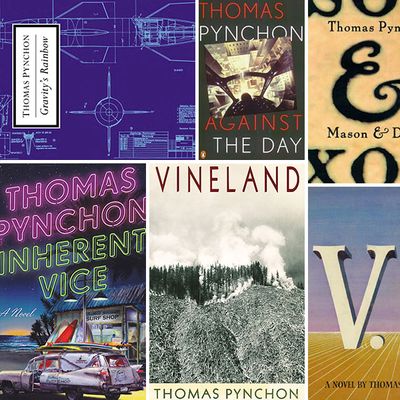
When you read enough of Thomas PynchonÔÇÖs novels (actually, make that┬áany┬áof his fiction), you begin to understand why the author has gone out of his way to stay out of the public eye since the 1960s. PynchonÔÇÖs view of the world is strange ÔÇö people are shady, corporations are never up to any good, and weÔÇÖre all going to go through this life and never find the answers to some of our bigger questions. Whether itÔÇÖs the massive┬áGravityÔÇÖs Rainbow, a book considered a life accomplishment to some upon completion; or Inherent ViceÔÇÖs paranoid, psychedelic take on hard-boiled detective fiction (immortalized onscreen in Paul Thomas AndersonÔÇÖs adaptation, a Pynchon first), thereÔÇÖs always something ominous on the horizon in the authorÔÇÖs books.
Sounds grim? Not necessarily. The great thing about Pynchon is that, like a number of his contemporaries, heÔÇÖs always been able to write on these topics with the sly smile of a stoned trickster who has a deeper understanding of the complexities of our world, but ultimately is probably just as confused and mystified as the rest of us. That is why people obsess over his oeuvre the way they do. Here is a very brief ranking of his body of work.
8. Against the Day
The longest Pynchon novel might also be the hardest to follow. With over 100 characters from all over the globe and a number of episodes spread over a handful of chapters, the book stretches from the Chicago WorldÔÇÖs Fair of 1893 all the way to the end of the World War I. All of his books are complex, but thereÔÇÖs something about┬áAgainst the Day┬áthat makes it the sort of book you approach only when youÔÇÖre already comfortable with Pynchon.
7. Bleeding Edge
Pynchon looks at New York in the days leading up to and after 9/11 in this mystery march up and down Silicon Alley. For a writer who has been able to make confusing times seem that much stranger, PynchonÔÇÖs┬áBleeding Edge┬áis particularly interesting because, besides maybe Philip K. Dick or William Gibson, there are few writers whom you could say the internet was made for.
6. Vineland
Leave it to the author who did the best job of summing up the weirdness of the peace-and-love 1960s to perfectly knock the decade down a few notches by highlighting what it wrought ÔÇö┬ánamely, Nixon, Reagan, the War on Drugs, and ongoing class warfare, all set in 1984. Released in 1990, this novel presents a time thatÔÇÖs confusing and strange along the lines of anything George Orwell could have imagined.
5. Inherent Vice
Trying to connect the dots when it comes to PynchonÔÇÖs work could drive a person insane┬áÔÇö but there is something resembling a line that could be drawn from┬áThe Crying of Lot 49 (youÔÇÖll see why in a few paragraphs) to this 2009 stoner-noir. Initially not as beloved as some of his earlier works, Inherent Vice is a weird and wonderful book that deserved another chance even before Paul Thomas Anderson turned it into a film.
4. V
A glimpse of things to come, Pynchon threw everything including the kitchen sink into this time-spanning 1963 debut that should very well stand beside books like William BurroughsÔÇÖs┬áNaked Lunch┬áand Kurt VonnegutÔÇÖs CatÔÇÖs Cradle┬áas works that helped totally shift the landscape of the American novel in the postwar era.
3. Mason & Dixon
Since he doesnÔÇÖt communicate with his readers, itÔÇÖs impossible to know the hows and whys of PynchonÔÇÖs inner workings. ThatÔÇÖs what makes Mason & Dixon┬áso interesting: We have to wonder how this fits in between his other works, and why it supposedly took him two decades to write this epic tale of the famed surveyors and astronomers who are responsible for the line that splits America. With plenty of religious conspiracies and astrological speak, this is Pynchon doing historical fiction, and itÔÇÖs great.
2. GravityÔÇÖs Rainbow
There are great novels, and then there are great┬ábig┬ánovels.┬áGravityÔÇÖs Rainbow┬ástands comfortably between Herman MelvilleÔÇÖs┬áMoby-Dick┬áand David Foster WallaceÔÇÖs┬áInfinite Jest┬áas the type of large, American book that true fans will read and reread to see what they missed the first time around. The co-winner for the 1974 U.S. National Book Award for Fiction (along with┬áA Crown of Feathers and Other Stories┬áby Isaac Bashevis Singer) sits at the top of the mountain of paranoid, postwar/Cold War masterpieces (along the lines of works by Joseph Heller, Kurt Vonnegut, Rudolph Wurlitzer,┬áand┬áDon DeLillo) that helped us visualize the senselessness that is war. Here the author presented over 700 pages filled with many characters, a narrative that demanded your attention, and some metaphysics thrown in for good measure.
1. The Crying of Lot 49
ItÔÇÖs a novella in comparison to┬áGravityÔÇÖs Rainbow, but this, his most Pynchon-esque novel, is also one of the defining books of the decade in which it came out. No matter where you go in his body of work, youÔÇÖre going to travel down a postmodern labyrinth that reeks of pot, but whatÔÇÖs hard to believe about PynchonÔÇÖs second book, released in 1966, is that he was able to fit so much of this story into such a small space. Oedipa Maas travels around southern California while trying to uncover a┬áconspiracy theory involving an underground mail service after her rich boyfriend dies ÔÇö thatÔÇÖs not exactly a light plot. ItÔÇÖs really where you should start if youÔÇÖre trying to get into Pynchon, and the book you can always go back to if youÔÇÖre already a fan.

